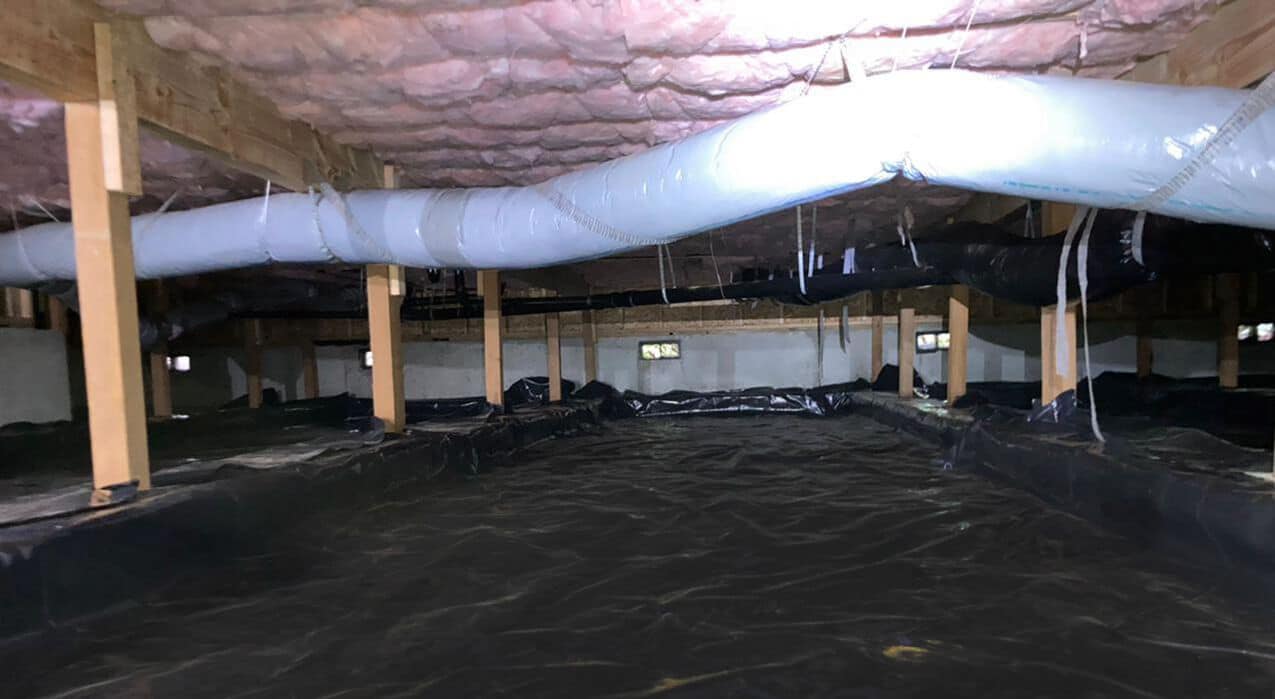The number one enemy of any homeowner is moisture; it breeds mold and mildew and causes problems for many different house components. Problems associated with moisture can compromise your home’s structural integrity, resulting in some very steep repair bills. The worst place for moisture to linger in your home is the crawl space.
The crawl space is the space under a house between the ground and the underside of the first floor. Learning how to use a vapor barrier in a crawl space will minimize moisture and prevent the issues that come with it.
What Is a Crawl Space Vapor Barrier?
A vapor barrier is a moisture barrier for crawl spaces that prevents water vapor from infiltrating the area. They usually consist of a heavy-duty plastic material that lays over the soil underneath a house.
Importance of Crawl Space Vapor Barrier
The dirt floor of your crawl space holds a lot of moisture which will infiltrate your home or building. If this moisture issue goes unaddressed, it can lead to various problems, such as:
- Electrical Troubles
- Structural Damage
- Pipe Erosion
- Destroyed Insulation
- Spread of Allergens
Problems Caused by Moisture
Moisture can wreak serious havoc on a house’s structural properties and foundation. Preventative measures are the best way to stop liquid water or water vapor from damaging expensive components of your home. Some of the biggest problems caused by moisture in a crawl space include:
Mold and Mildew
One of the worst issues moisture in a crawlspace can cause is the growth of mold and mildew. Mold is notoriously difficult to eliminate and leads to expensive and time-consuming problems.
Crawl space moisture can cause mold to overtake floor cavity insulation and structural components. With minimal light and ventilation, mold issues will only worsen without prevention or restoration. Crawl space moisture control saves homeowners thousands of dollars in repairs.
Rotting
Wooden elements underneath a house will eventually rot if exposed to moisture for too long. Such items include beams, joists, posts, and more.
Pests
Animals head for places with water, and your dark, enclosed crawl space is a cozy, safe place for them to nest. Crawl space moisture can attract all sorts of pests, including:
- Rats
- Mice
- Termites
- Snakes
- Skunks
- Carpenter ants
- Feral cats
- Roaches
- Spiders

Is a Vapor Barrier Really Necessary for Your Crawl Space?
Many people who live in dry climates think they can go without a crawl space vapor barrier because there isn’t enough moisture in the soil to create a problem. However, when Advanced Energy Conducted a study in Flagstaff, Arizona, it found that those with a vapor barrier under the house saw a 15% savings on their energy bill. This lower energy bill is the result of minimized moisture under the house, which can make it more difficult to control the temperature inside.
No matter where your home is, crawlspace moisture control will save you money on energy, maintenance, and repair bills.
How Do Vapor Barriers Work?
Learning how to use a vapor barrier in crawl space areas can save you time and money. Heavy-duty plastic covers the soil in the crawlspace, preventing moisture from contaminating the wood, piping, and structural components. Vapor barriers will not protect your home or building from leaky pipes or rainwater runoff, and it’s best to make sure there are no other sources of substantial moisture in your crawl space before adding a vapor barrier.
Benefits of Vapor Barriers in Crawl Spaces
Crawl space vapor barriers do a lot to keep your home or building in a healthy state. Some of the benefits of vapor barriers are:
Prevention of Wiring Hazards
Your crawlspace has wiring and junction boxes that should not ever get wet. Wet electrical components can malfunction, start a fire, or shock someone. A vapor barrier provides an additional protective layer between wires and sources of moisture.
Prevention of Corrosion and Rust
Any ductwork, HVAC components, or other metal materials in your crawl space will rust due to significant moisture. Water degrades metal quickly, so even brand-new metallic elements are at risk. Putting a vapor barrier in the crawlspace protects metal items, sparing you from needing repairs or replacement.
Making Your Home More Comfortable
Eliminating excess moisture in your home or building improves the air quality. Better air quality makes it easier for you to breathe and makes you healthier. Improving the comfort level in your home not only improves your quality of life but it helps when it’s time to sell the house later.
Improving Accessibility to Your Crawlspace
Vapor barriers make crawl spaces easy to get into and work inside. The vapor barrier makes it so you don’t have to crawl around in the dirt every time you have to do something in the crawl space. It makes work go faster and creates a healthier, safer environment.
Frequently Asked Questions (FAQs) – Crawl Space Vapor Barrier
What Type of Vapor Barrier Should Be Used for Crawl Space?
Building code requires the use of a class I vapor barrier for crawl spaces. A class I vapor barrier consists of plastic with no more than 0.1 permeance. Permeance is the amount of moisture vapor that passes from one side of a material to the other.
Can I Install a Vapor Barrier Myself?
Many homeowners install vapor barriers on their own. Be sure to measure your crawlspace accurately to determine the square feet of liner you will need. If you’re not confident in your ability to install the liner, Attic Projects attic and crawl space experts can help.
How Thick Should a Crawl Space Vapor Barrier Be?
Vapor barriers should measure ten mils or higher. A mil is a unit of measurement equal to 0.001 of an inch.
Conclusion
Now that you know how to use a vapor barrier in a crawl space, get yours installed ASAP. Controlling moisture in a crawl space is imperative. Call Attic Projects today to get a free quote, or contact us online for any questions or concerns!



